EeePC 1018P - ah yes krasava!
And hello! Remember, in the summer I made a post with an ambiguous title “ Hurray! », In which he said that ASUS is preparing three new interesting netbooks? I usually do not write such announcements, preferring to write only about what I “felt” myself. But at that time, I thought that netbooks are worthy of attention.

And, as it turned out, was not mistaken. Under the cut - a review of one of those three.
You understand the first advantages of a netbook when you take it in hand - it is comfortable to hold, it is rather light and generally very compact. The thickness of the case is only 18 millimeters, which is decently thinner than my EeePC 1002HA , for example.
')
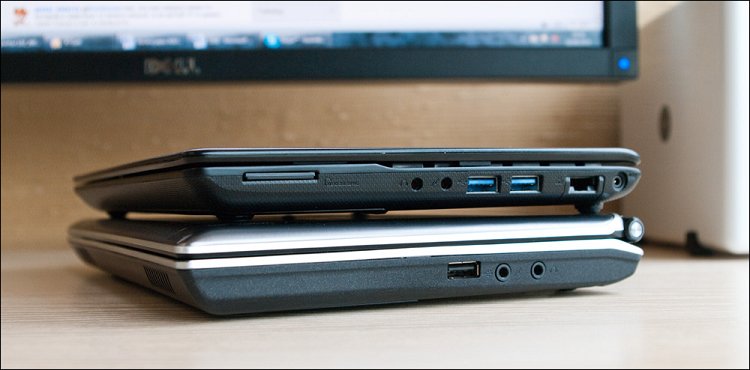
Netbook comes in two colors - black and silver. I do not know how “light-colored”, but “dark” is just a dude - it has a metal cover with a fine polishing texture. The “Eee” inscription, which, for some reason, was not liked by many, was disappeared - instead of it, the ASUS metal nameplate.
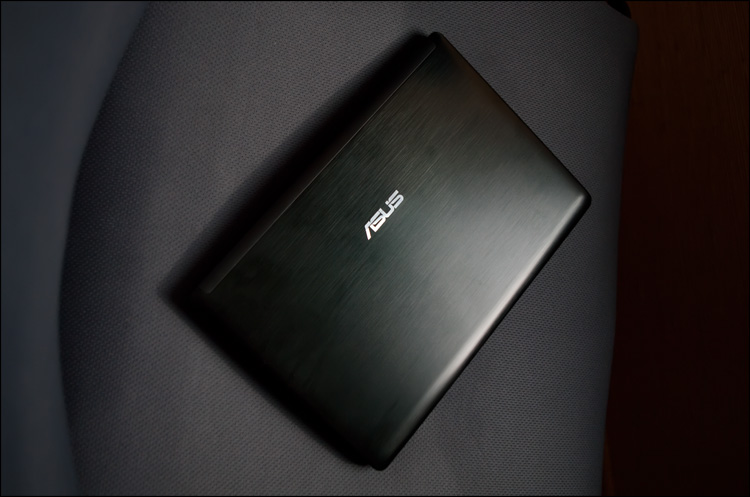
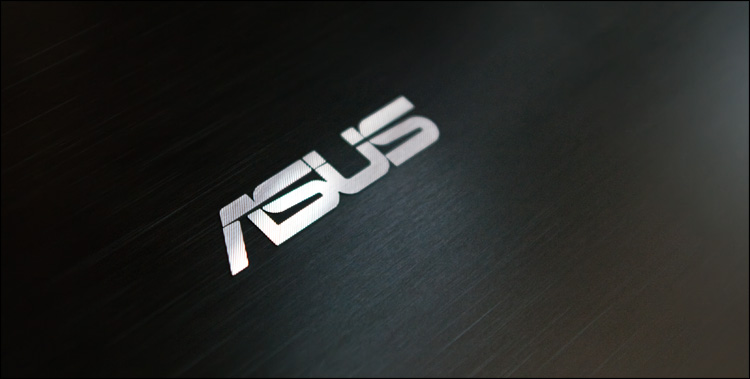
The back side is made of a nice plastic with a "porous" pattern.
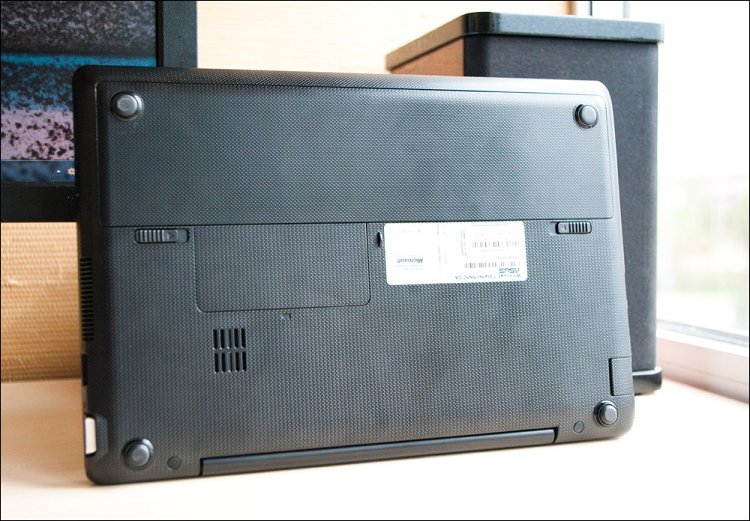
Minimalism reigns on the bottom - 4 rubber feet and two clamps that hold the battery (Li-Polymer, 7.4V, 6000mAh, 44Wh) - most of the stickers are just under it. By pulling out the battery, you can remove the RAM cover - it is convenient that you can do without a screwdriver.


Opening the netbook, I noticed a very thin cover - 5 millimeters, not more. But at the same time, it was perfectly tested for twisting type deformation - the reverse metal side gives the necessary strength.
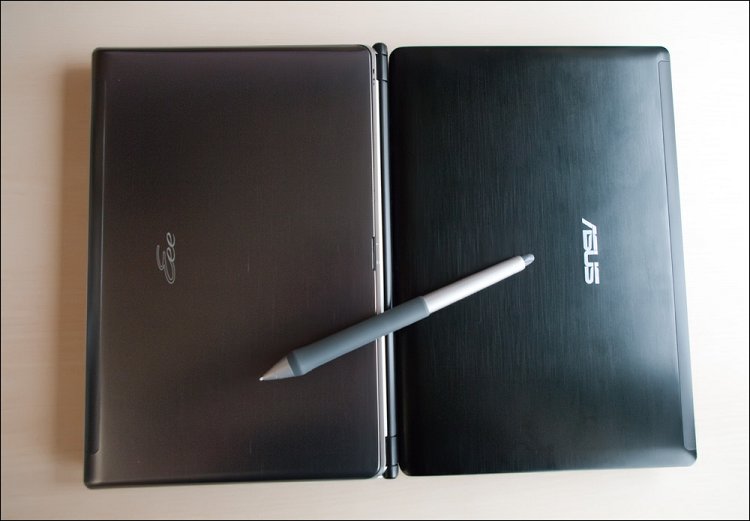
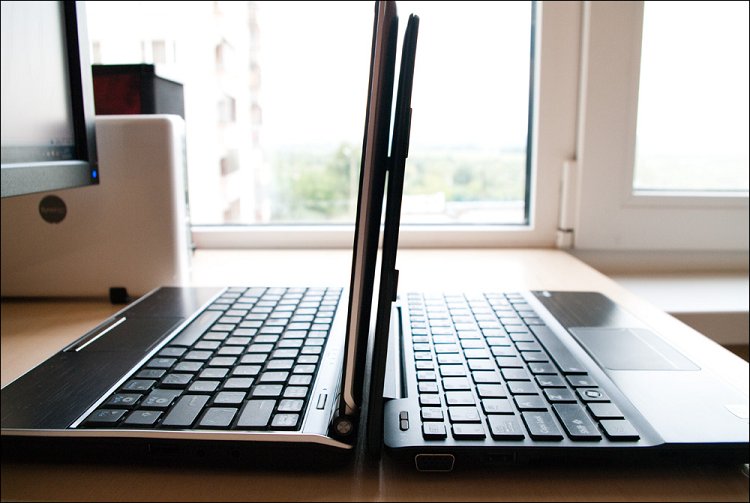
Finally made a glossy display! And then everything is matte, but matte ... :) In fact, the issue with a glossy screen is solved here with a matte film, but everything else is matte, including the frame around the screen! Matte body, space around the touchpad and keyboard - no prints or highlights, just some kind of holiday!
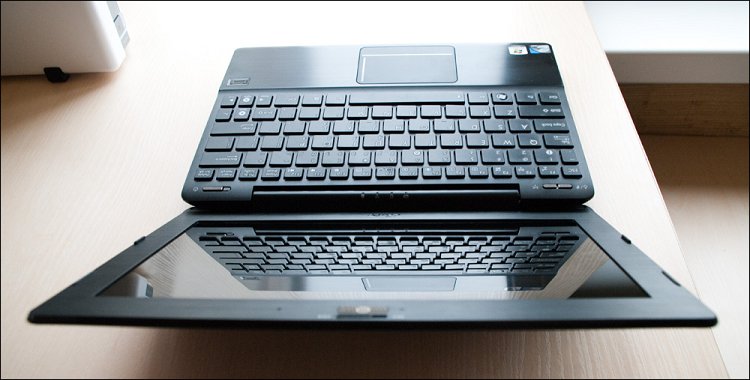
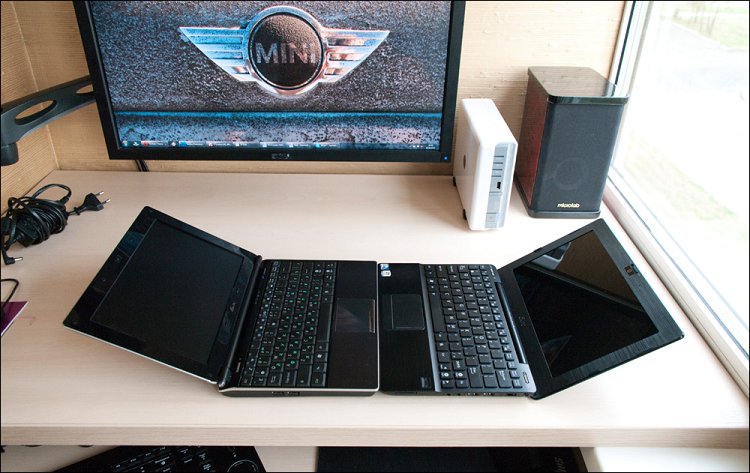
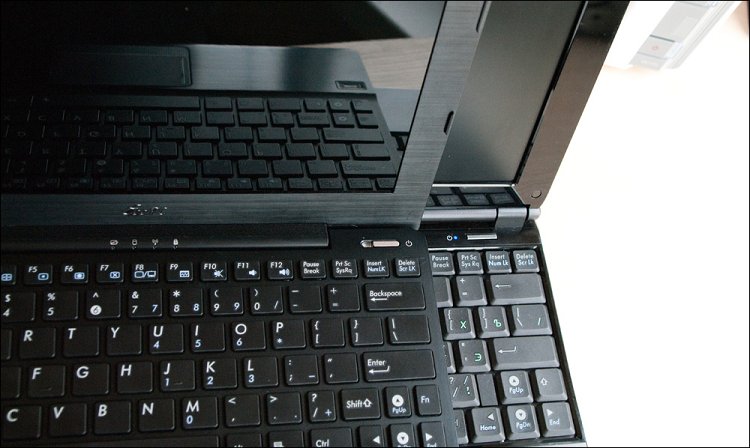
The screen has a diagonal of 10.1 "and has a standard resolution for this diagonal - 1024x600. Not much, but what to do ...
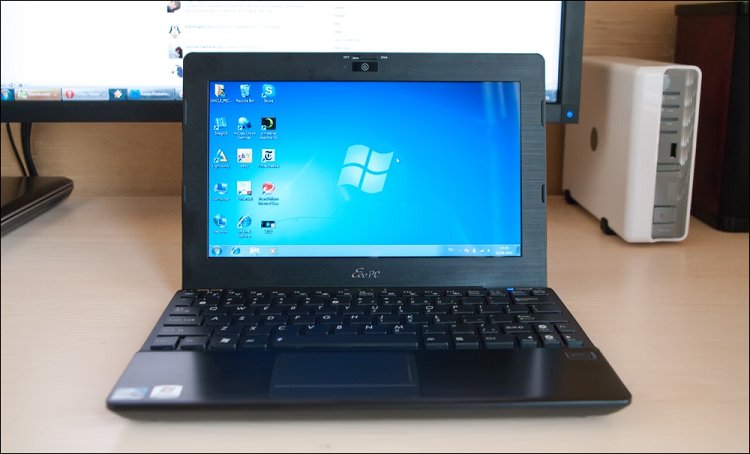
Briefly on the connectors. Even on the reverse side, you could see a bulging connector - this is the good old VGA, which for some reason (due to the projectors?) Is still not going to leave us; every year the old man is becoming more and more difficult to fit into the shells of mobile devices. And the RJ45 connector in this regard is even more difficult. At 1018P, the network connector made a special flap to avoid spoiling the overall appearance.
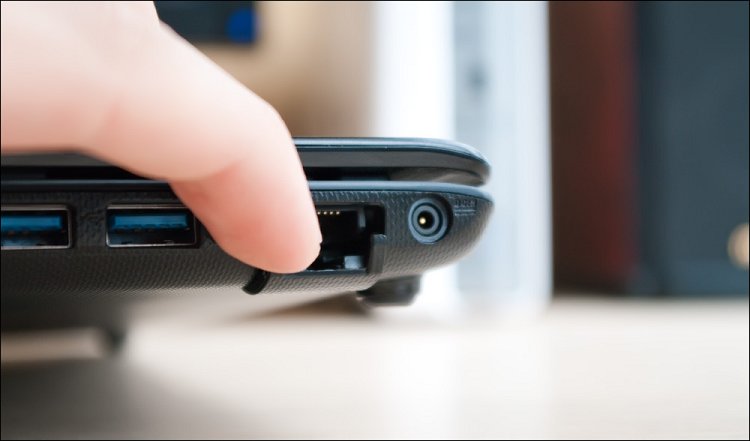
Audio connectors (3.5mm) finally got rid of colored rings - now they are just two strict connectors on the right side of the device. There are also two USB 3.0 connectors, an SD card slot and a power connector. By the way, the adapter is quite small - the same as in many new netbooks. But here the thin power plug in it does not inspire confidence in me at all.
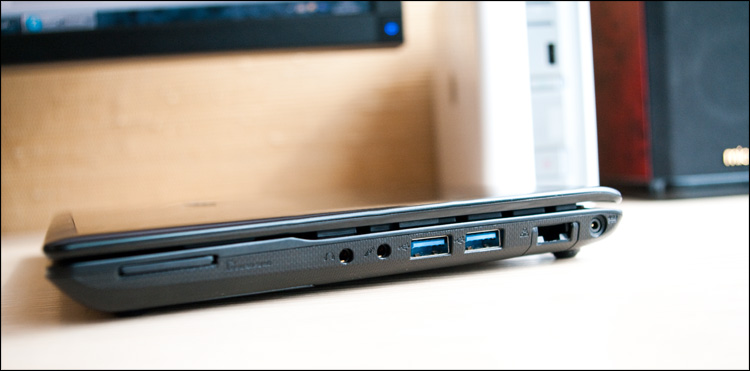
There is nothing behind, just like the front. On the left - another USB (2.0), VGA and anti-theft lock. Well and air vents.
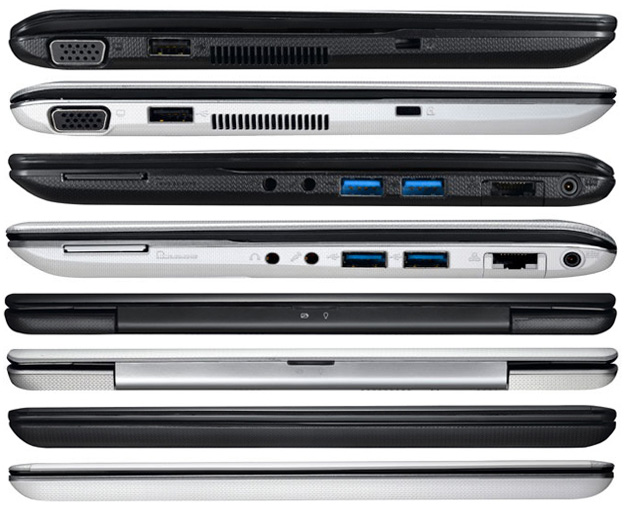
Above the screen is a webcam (only 0.3 megapichar), which has a movable shutter. Contrary to an erroneous opinion, the curtain does not scratch the opposite part of the body - this is prevented by embossed inserts in a frame on the sides of the screen.


Under the screen - a small hinge with built-in LEDs. There are only 4 of them and they do not distract even at night.
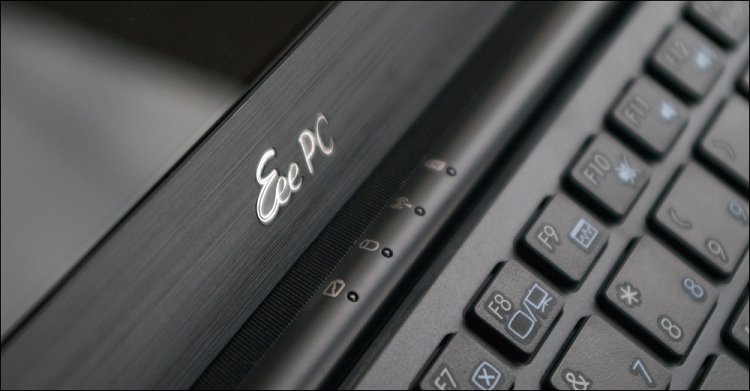
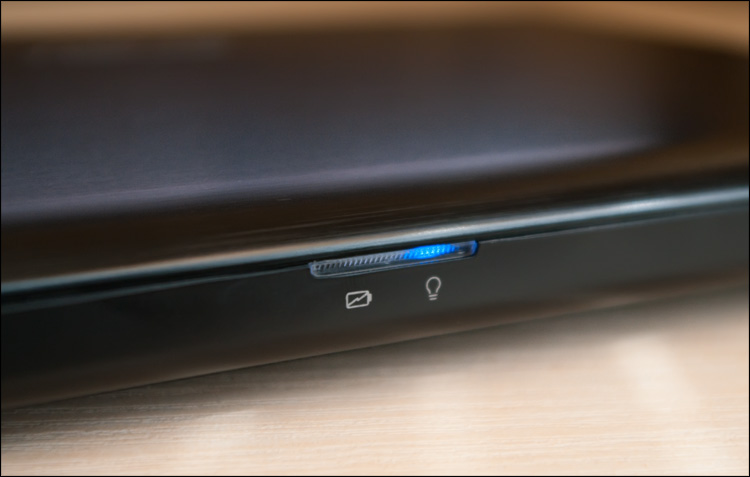
As I already said, all the space around the touchpad and the keyboard is entirely metallic, absolutely unmarked and pleasantly cool. As a bonus, a pleasant keyboard for printing with the “right” layout is the large Enter, Backspace and two Shift keys, and with them the second Fn key on the right.
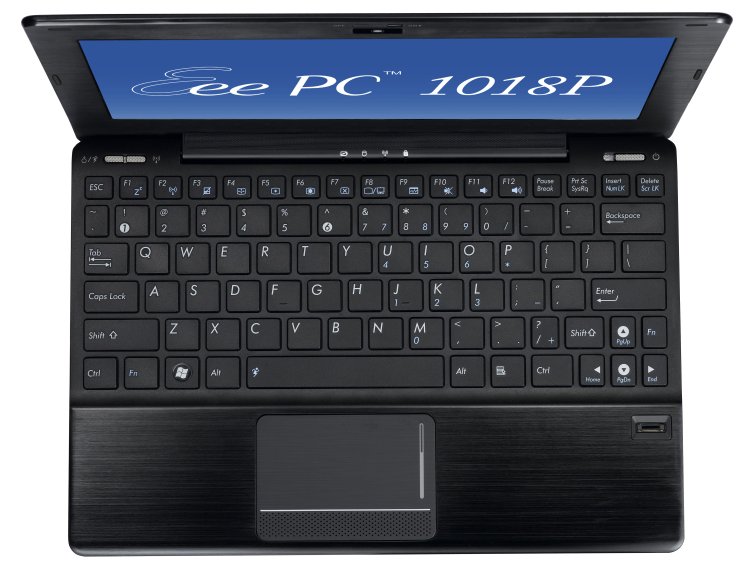
Busy and usually empty Fn + F3 and Fn-F4 - now these combinations in (s) switch on the touchpad and change the resolution on the move (800x600, 1024x600, 1024x768). Another difference from the usual ASUS netbook layouts - c Fn + X and Fn + C - the combinations for the camera disappeared. Eh, there would be a backlight, in general there would be no price.
The touchpad is multi-touch, it is not pressed in any way and does not protrude from the case - just a nice touchpad without any frills. Finally, they got rid of the chrome button - now a plastic insert with a surface made of embossed “dots” has taken its place.
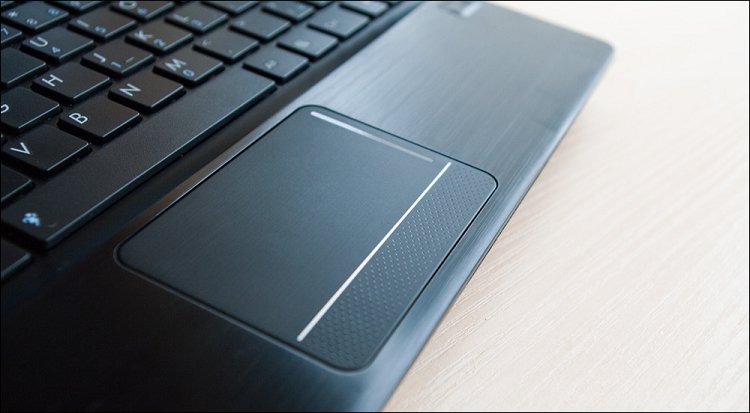
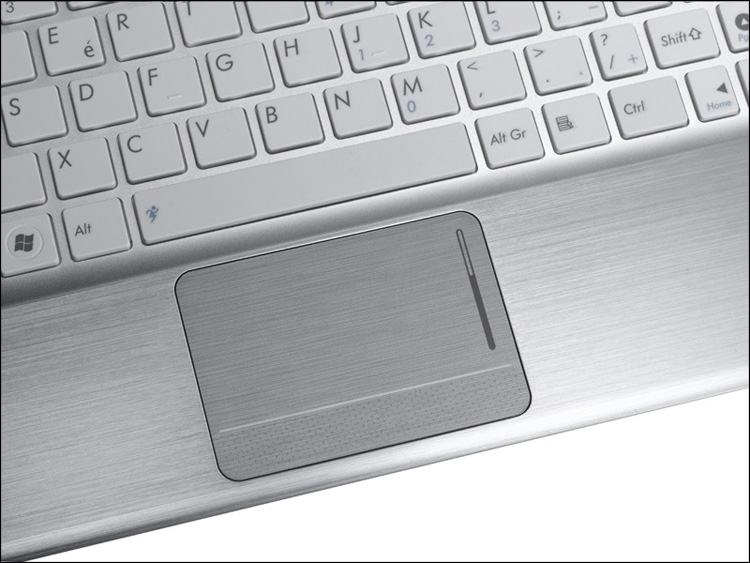
To the right of the touchpad is a fingerprint scanner.
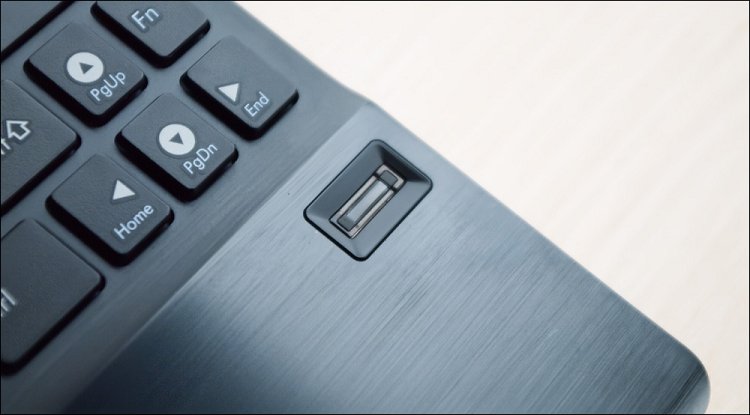
If you believe the Internet, here is a photo of the silver version - it looks like it is even more elegant.
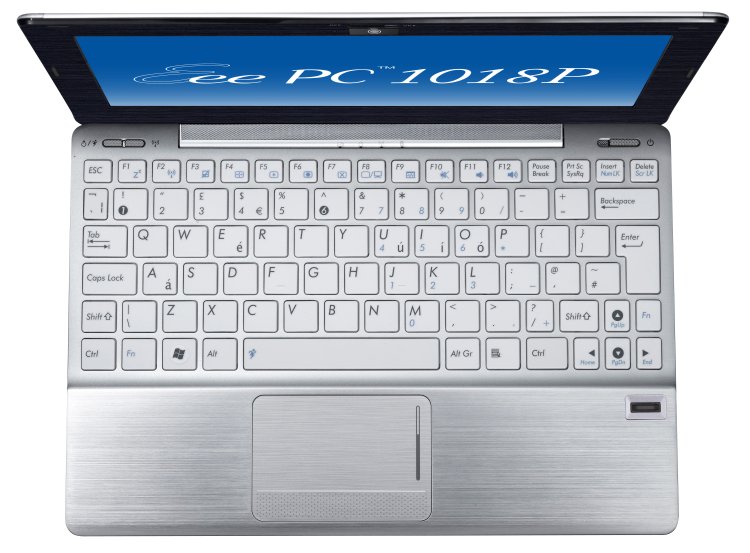
As it is now fashionable in ASUS laptops, there are two power buttons. The right one loads the preinstalled Windows Starter - it takes exactly 30 seconds. The second button (on the left; it is also responsible for Wi-Fi) loads the netbook into an updated version of the pre-installed Linux distribution of ASUS ExpressGate, which takes 7 seconds already. Not bad.
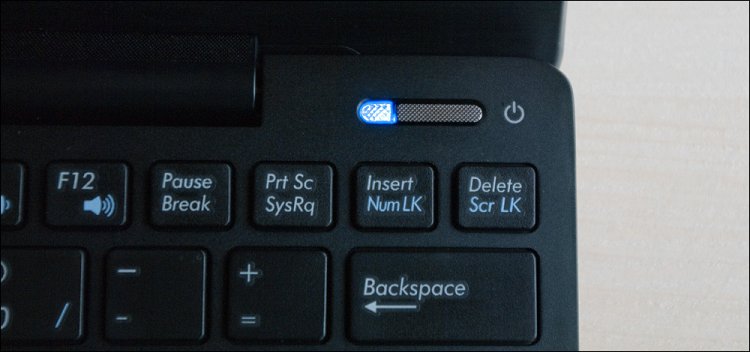
By the way, about Windows. Few people know that the majority of ASUS netbooks and laptops on the hard drive have a hidden partition - there is obviously working Windows with the “factory” settings, firewood and more software stored there. This is a very good bonus in case you need to “reanimate” the killed OS, even a novice user will cope with - just press F9 at the boot time and the device will offer to “recover”. I tell it only because some “purebred” iron publications do not even know this - it was not the first time that I came across engineering samples (straight from Taiwan - without stickers and Russian letters on the layout, without Windows - more precisely, with its image on the disk, which first you need to deploy), on which the "craftsmen" put their bare OS without firewood and other buns. It is unclear how they test some functions, such as a camera or a fingerprint scanner :) At first, I myself was so messy until I noticed a strange “presence” on the disk. Here it is.
When the operating system boots up, the button for launching ExpressGate turns into a button for controlling performance modes — well, saving mode, performance, etc. In the case of ASUS, this technology is called Super Hybrid Engine.
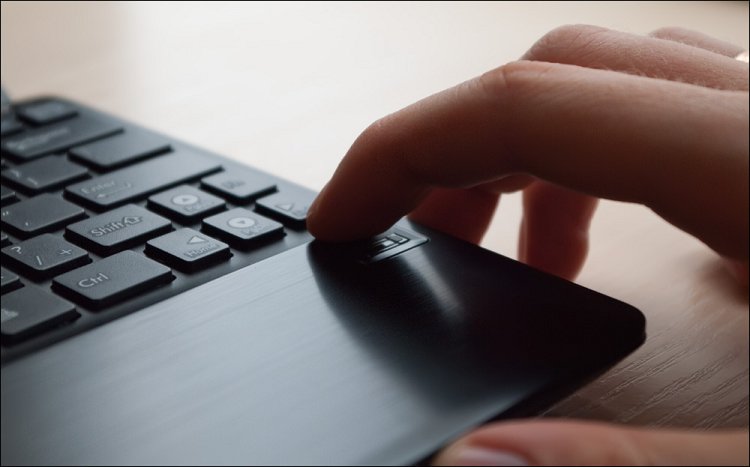
AuthenTec TrueSuite utility is responsible for the fingerprint scanner, which allows you to log in with your finger and block it; launch sites, applications, etc. For many, this function is not needed, but I would love to use it. And if you could make friends with a scanner with a program like Password Commander or KeePass, then this is generally a dream. Prints are recognized very skillfully, even if carried out very quickly.
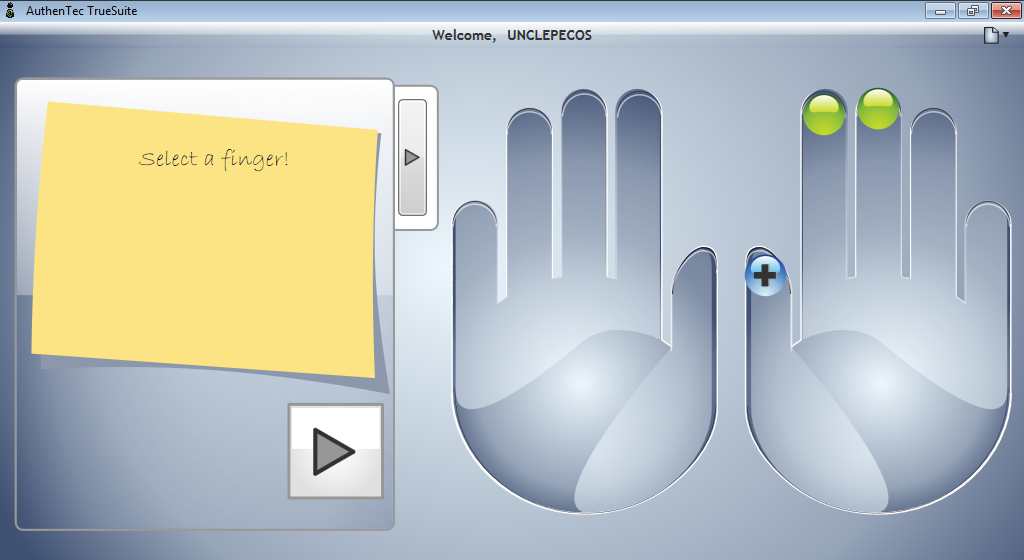

Inside the 1018P, the Intel® Atom ™ N475 processor with a clock frequency of 1.83 GHz and 512 KB cache (Intel NM10 chipset) is announced this summer. 2 gigabytes of RAM (DDR2 667 MHz) with one bar - a pity, but the slot is only 1 and higher than the bar. Integrated Intel GMA 3150 video system.
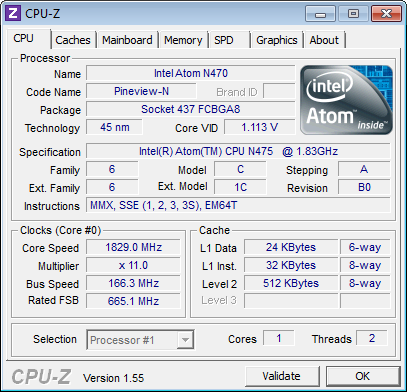
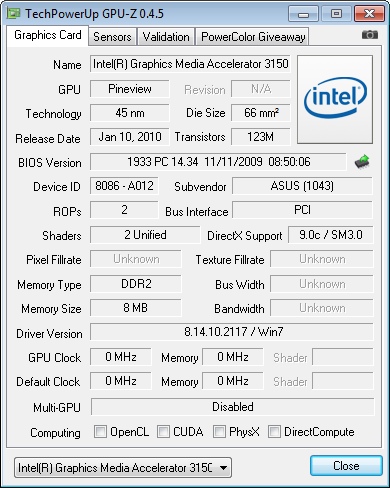
In aggregate, all this gives a performance index of 2.6.
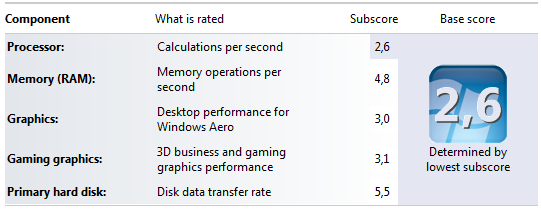
The number is far from the biggest, but it is worth remembering that it is abstract - the netbook performance was enough for all my tasks. And 20 tabs in the opera, and all there Skype with offices, and even HD-video (720p - easily).


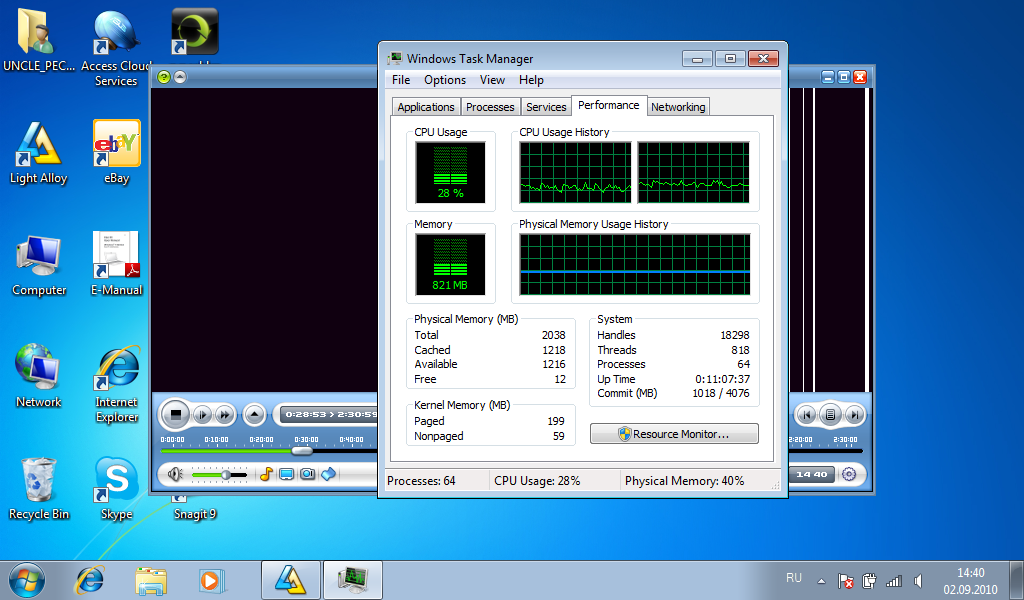
The hard drive can be installed either on 250GB or 320. In my case, the WD drive was installed on 320GB - these are its speed indicators:

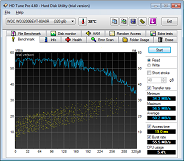
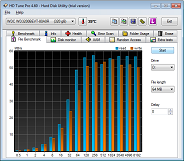

With a 100% charge of a regular battery, the battery life is about 5 hours - not enough, of course, at the same institute it's just two pairs and a break ... but on the other hand, there are a lot of netbooks that work even less.
The picture quality on the screen is very good, although the screen is blind in the sun. From the sound of a miracle did not expect - it is, but the headphones in this matter is much preferable.
And yet - under load the netbook heats up well, but the temperatures are non-critical. But it works very quietly - maybe the cooler didn’t work there? :)
Processor : Intel® Atom ™ N455 / N475 (1.66 / 1.83GHz, 1 core, 512KB L2)
Chipset : Intel® NM10
RAM : 2048MB (DDR2, 667MHz). 1 slot
Hard disk : 250 or 320 GB (2.5 ”, SATA2, 5400 r / m) + 500 GB on EeeStorage
Graphics Card : Intel® GMA 3150
Screen : 10.1 ", glossy (1024x600, with LED-backlit)
Interfaces : 1xUSB 2.0, 2xUSB 3.0, VGA, Head Phone, Mic-in, RJ45 (gigabit)
Optical drive : no
Card reader : SD / MMC / MS / MSPro / xD
Webcam : 0.3 megapixel
Wireless : Bluetooth v.3, 802.11b / g / n
Optional : fingerprint scanner
Battery : Li-Polymer (7.4V, 6000mAh, 44Wh, 4 elements)
Battery life : 4-5 hours
Operating System : Microsoft® Windows 7 Starter + ASUS ExpressGate
Dimensions : 262x179x18 ~ 22 mm
Weight : 1.1 kg (with battery)
 Light and thin
Light and thin
 Excellent build quality
Excellent build quality
 Stylish metal case without gloss
Stylish metal case without gloss
 Comfortable keyboard and large touchpad
Comfortable keyboard and large touchpad
 Bluetooth 3.0, two USB 3.0 ports
Bluetooth 3.0, two USB 3.0 ports
 Offline operation up to 5 hours
Offline operation up to 5 hours
 Good performance
Good performance
 ASUS ExpressGate available
ASUS ExpressGate available
 Fingerprint scanner
Fingerprint scanner
There are few disadvantages and they are not that big:
 Slim adapter plug (be careful)
Slim adapter plug (be careful)
 Tight button at the touchpad (a matter of habit)
Tight button at the touchpad (a matter of habit)
 Glossy display (film treated)
Glossy display (film treated)
 1024x600 (this is the standard for 10 '')
1024x600 (this is the standard for 10 '')
 No nVidia Ion (and so wanted to!)
No nVidia Ion (and so wanted to!)
 Heats up in the load (but not much)
Heats up in the load (but not much)
 The netbook is already on sale, the numbers on the price list start at 16,500 rubles. On the one hand, this is “a couple of thousand more and you can take a laptop,” on the other hand, less worthy netbooks cost almost as much. Oh, and be inside nVidia Ion, the netbook would be just a bomb!
The netbook is already on sale, the numbers on the price list start at 16,500 rubles. On the one hand, this is “a couple of thousand more and you can take a laptop,” on the other hand, less worthy netbooks cost almost as much. Oh, and be inside nVidia Ion, the netbook would be just a bomb!
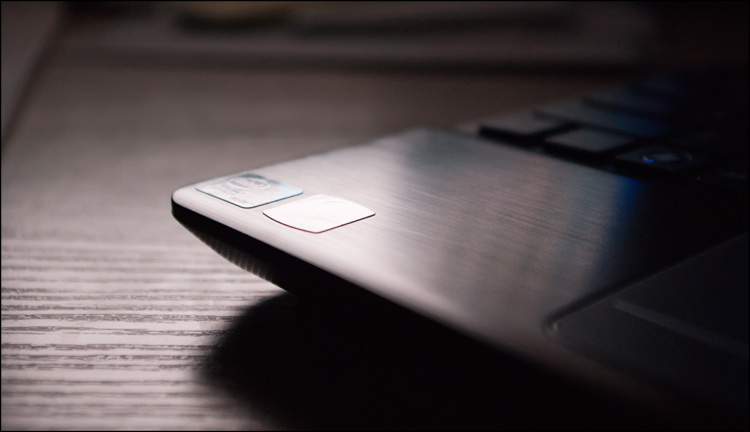
Definitely a cool netbook, in which the company took into account many previous mistakes (perhaps this is part of a large marketing strategy, which cannot be ruled out). The device has taken all the best that the company has ever had in the netbook segment - from a practical case and attention to details such as connectors, ending with a convenient keyboard layout and a convenient touchpad. And all this is served under the delicious sauce of new technologies - USB 3.0, Bluetooth 3, the new Intel Atom processor, the new fingerprint scanner.
As elsewhere, there are drawbacks - in this case, in my opinion, nVidia Ion is not enough for complete happiness, which could easily increase the benefits. The battery life is 5 hours - this is a good figure, but still, this is not enough for many. But here the whole thing is already in the battery, the choice of which is explained by the desire to create a truly mobile device. Someone even likes the glossy screen, and everyone else can use a matte film; but sooner or later you will get used to the tight touchpad. 1024x600? Not enough, of course, but for 10 inches it is standard, so there is no choice.

In general ... it turned out very worthy. Stylish, productive, practical. I ’ve been looking for a replacement for my outdated 1002HA for a long time - I’m waiting for a “sporty” ASUS VX6 netbook and if it doesn’t impress (or turns out to be very expensive), then I’ll definitely buy 1018P - it’s more convenient with a netbook in everyday life than with a laptop. If you need a netbook right now, and the shortcomings I have found do not confuse you, then I can advise this netbook. At least, at the moment in the arsenal of ASUS with a screen of 10 "" I have not seen anything better.
Next time I will talk about the “ionic” netbook EeePC 1215n .
* UPD * The secret for me was one connector under the battery - for the SIM-card. I noticed him at the very last moment, when I already gave away the laptop. The connector was a surprise for everyone) So I do not exclude that the laptop has 3G support, which may be useful to someone. Or maybe it’s just an engineering sample trick - I don’t know.
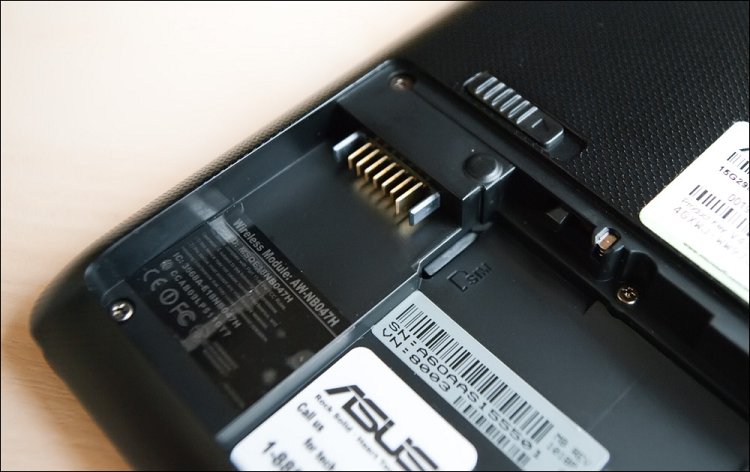
Successes!

And, as it turned out, was not mistaken. Under the cut - a review of one of those three.
Appearance
You understand the first advantages of a netbook when you take it in hand - it is comfortable to hold, it is rather light and generally very compact. The thickness of the case is only 18 millimeters, which is decently thinner than my EeePC 1002HA , for example.
')

Netbook comes in two colors - black and silver. I do not know how “light-colored”, but “dark” is just a dude - it has a metal cover with a fine polishing texture. The “Eee” inscription, which, for some reason, was not liked by many, was disappeared - instead of it, the ASUS metal nameplate.


The back side is made of a nice plastic with a "porous" pattern.

Minimalism reigns on the bottom - 4 rubber feet and two clamps that hold the battery (Li-Polymer, 7.4V, 6000mAh, 44Wh) - most of the stickers are just under it. By pulling out the battery, you can remove the RAM cover - it is convenient that you can do without a screwdriver.


Opening the netbook, I noticed a very thin cover - 5 millimeters, not more. But at the same time, it was perfectly tested for twisting type deformation - the reverse metal side gives the necessary strength.


Finally made a glossy display! And then everything is matte, but matte ... :) In fact, the issue with a glossy screen is solved here with a matte film, but everything else is matte, including the frame around the screen! Matte body, space around the touchpad and keyboard - no prints or highlights, just some kind of holiday!



The screen has a diagonal of 10.1 "and has a standard resolution for this diagonal - 1024x600. Not much, but what to do ...

Briefly on the connectors. Even on the reverse side, you could see a bulging connector - this is the good old VGA, which for some reason (due to the projectors?) Is still not going to leave us; every year the old man is becoming more and more difficult to fit into the shells of mobile devices. And the RJ45 connector in this regard is even more difficult. At 1018P, the network connector made a special flap to avoid spoiling the overall appearance.

Audio connectors (3.5mm) finally got rid of colored rings - now they are just two strict connectors on the right side of the device. There are also two USB 3.0 connectors, an SD card slot and a power connector. By the way, the adapter is quite small - the same as in many new netbooks. But here the thin power plug in it does not inspire confidence in me at all.

There is nothing behind, just like the front. On the left - another USB (2.0), VGA and anti-theft lock. Well and air vents.

Above the screen is a webcam (only 0.3 megapichar), which has a movable shutter. Contrary to an erroneous opinion, the curtain does not scratch the opposite part of the body - this is prevented by embossed inserts in a frame on the sides of the screen.


Under the screen - a small hinge with built-in LEDs. There are only 4 of them and they do not distract even at night.


As I already said, all the space around the touchpad and the keyboard is entirely metallic, absolutely unmarked and pleasantly cool. As a bonus, a pleasant keyboard for printing with the “right” layout is the large Enter, Backspace and two Shift keys, and with them the second Fn key on the right.

Busy and usually empty Fn + F3 and Fn-F4 - now these combinations in (s) switch on the touchpad and change the resolution on the move (800x600, 1024x600, 1024x768). Another difference from the usual ASUS netbook layouts - c Fn + X and Fn + C - the combinations for the camera disappeared. Eh, there would be a backlight, in general there would be no price.
The touchpad is multi-touch, it is not pressed in any way and does not protrude from the case - just a nice touchpad without any frills. Finally, they got rid of the chrome button - now a plastic insert with a surface made of embossed “dots” has taken its place.


To the right of the touchpad is a fingerprint scanner.

If you believe the Internet, here is a photo of the silver version - it looks like it is even more elegant.

Turn on and work
As it is now fashionable in ASUS laptops, there are two power buttons. The right one loads the preinstalled Windows Starter - it takes exactly 30 seconds. The second button (on the left; it is also responsible for Wi-Fi) loads the netbook into an updated version of the pre-installed Linux distribution of ASUS ExpressGate, which takes 7 seconds already. Not bad.

By the way, about Windows. Few people know that the majority of ASUS netbooks and laptops on the hard drive have a hidden partition - there is obviously working Windows with the “factory” settings, firewood and more software stored there. This is a very good bonus in case you need to “reanimate” the killed OS, even a novice user will cope with - just press F9 at the boot time and the device will offer to “recover”. I tell it only because some “purebred” iron publications do not even know this - it was not the first time that I came across engineering samples (straight from Taiwan - without stickers and Russian letters on the layout, without Windows - more precisely, with its image on the disk, which first you need to deploy), on which the "craftsmen" put their bare OS without firewood and other buns. It is unclear how they test some functions, such as a camera or a fingerprint scanner :) At first, I myself was so messy until I noticed a strange “presence” on the disk. Here it is.
When the operating system boots up, the button for launching ExpressGate turns into a button for controlling performance modes — well, saving mode, performance, etc. In the case of ASUS, this technology is called Super Hybrid Engine.

AuthenTec TrueSuite utility is responsible for the fingerprint scanner, which allows you to log in with your finger and block it; launch sites, applications, etc. For many, this function is not needed, but I would love to use it. And if you could make friends with a scanner with a program like Password Commander or KeePass, then this is generally a dream. Prints are recognized very skillfully, even if carried out very quickly.


Inside the 1018P, the Intel® Atom ™ N475 processor with a clock frequency of 1.83 GHz and 512 KB cache (Intel NM10 chipset) is announced this summer. 2 gigabytes of RAM (DDR2 667 MHz) with one bar - a pity, but the slot is only 1 and higher than the bar. Integrated Intel GMA 3150 video system.


In aggregate, all this gives a performance index of 2.6.

The number is far from the biggest, but it is worth remembering that it is abstract - the netbook performance was enough for all my tasks. And 20 tabs in the opera, and all there Skype with offices, and even HD-video (720p - easily).



The hard drive can be installed either on 250GB or 320. In my case, the WD drive was installed on 320GB - these are its speed indicators:




With a 100% charge of a regular battery, the battery life is about 5 hours - not enough, of course, at the same institute it's just two pairs and a break ... but on the other hand, there are a lot of netbooks that work even less.
The picture quality on the screen is very good, although the screen is blind in the sun. From the sound of a miracle did not expect - it is, but the headphones in this matter is much preferable.
And yet - under load the netbook heats up well, but the temperatures are non-critical. But it works very quietly - maybe the cooler didn’t work there? :)
Specifications
Processor : Intel® Atom ™ N455 / N475 (1.66 / 1.83GHz, 1 core, 512KB L2)
Chipset : Intel® NM10
RAM : 2048MB (DDR2, 667MHz). 1 slot
Hard disk : 250 or 320 GB (2.5 ”, SATA2, 5400 r / m) + 500 GB on EeeStorage
Graphics Card : Intel® GMA 3150
Screen : 10.1 ", glossy (1024x600, with LED-backlit)
Interfaces : 1xUSB 2.0, 2xUSB 3.0, VGA, Head Phone, Mic-in, RJ45 (gigabit)
Optical drive : no
Card reader : SD / MMC / MS / MSPro / xD
Webcam : 0.3 megapixel
Wireless : Bluetooth v.3, 802.11b / g / n
Optional : fingerprint scanner
Battery : Li-Polymer (7.4V, 6000mAh, 44Wh, 4 elements)
Battery life : 4-5 hours
Operating System : Microsoft® Windows 7 Starter + ASUS ExpressGate
Dimensions : 262x179x18 ~ 22 mm
Weight : 1.1 kg (with battery)
 Check weighing
Check weighing
 Light and thin
Light and thin Excellent build quality
Excellent build quality Stylish metal case without gloss
Stylish metal case without gloss Comfortable keyboard and large touchpad
Comfortable keyboard and large touchpad Bluetooth 3.0, two USB 3.0 ports
Bluetooth 3.0, two USB 3.0 ports Offline operation up to 5 hours
Offline operation up to 5 hours Good performance
Good performance ASUS ExpressGate available
ASUS ExpressGate available Fingerprint scanner
Fingerprint scannerThere are few disadvantages and they are not that big:
 Slim adapter plug (be careful)
Slim adapter plug (be careful) Tight button at the touchpad (a matter of habit)
Tight button at the touchpad (a matter of habit) Glossy display (film treated)
Glossy display (film treated) 1024x600 (this is the standard for 10 '')
1024x600 (this is the standard for 10 '') No nVidia Ion (and so wanted to!)
No nVidia Ion (and so wanted to!) Heats up in the load (but not much)
Heats up in the load (but not much) The netbook is already on sale, the numbers on the price list start at 16,500 rubles. On the one hand, this is “a couple of thousand more and you can take a laptop,” on the other hand, less worthy netbooks cost almost as much. Oh, and be inside nVidia Ion, the netbook would be just a bomb!
The netbook is already on sale, the numbers on the price list start at 16,500 rubles. On the one hand, this is “a couple of thousand more and you can take a laptop,” on the other hand, less worthy netbooks cost almost as much. Oh, and be inside nVidia Ion, the netbook would be just a bomb!
The end
Definitely a cool netbook, in which the company took into account many previous mistakes (perhaps this is part of a large marketing strategy, which cannot be ruled out). The device has taken all the best that the company has ever had in the netbook segment - from a practical case and attention to details such as connectors, ending with a convenient keyboard layout and a convenient touchpad. And all this is served under the delicious sauce of new technologies - USB 3.0, Bluetooth 3, the new Intel Atom processor, the new fingerprint scanner.
As elsewhere, there are drawbacks - in this case, in my opinion, nVidia Ion is not enough for complete happiness, which could easily increase the benefits. The battery life is 5 hours - this is a good figure, but still, this is not enough for many. But here the whole thing is already in the battery, the choice of which is explained by the desire to create a truly mobile device. Someone even likes the glossy screen, and everyone else can use a matte film; but sooner or later you will get used to the tight touchpad. 1024x600? Not enough, of course, but for 10 inches it is standard, so there is no choice.

In general ... it turned out very worthy. Stylish, productive, practical. I ’ve been looking for a replacement for my outdated 1002HA for a long time - I’m waiting for a “sporty” ASUS VX6 netbook and if it doesn’t impress (or turns out to be very expensive), then I’ll definitely buy 1018P - it’s more convenient with a netbook in everyday life than with a laptop. If you need a netbook right now, and the shortcomings I have found do not confuse you, then I can advise this netbook. At least, at the moment in the arsenal of ASUS with a screen of 10 "" I have not seen anything better.
Next time I will talk about the “ionic” netbook EeePC 1215n .
* UPD * The secret for me was one connector under the battery - for the SIM-card. I noticed him at the very last moment, when I already gave away the laptop. The connector was a surprise for everyone) So I do not exclude that the laptop has 3G support, which may be useful to someone. Or maybe it’s just an engineering sample trick - I don’t know.

Successes!
Source: https://habr.com/ru/post/104234/
All Articles